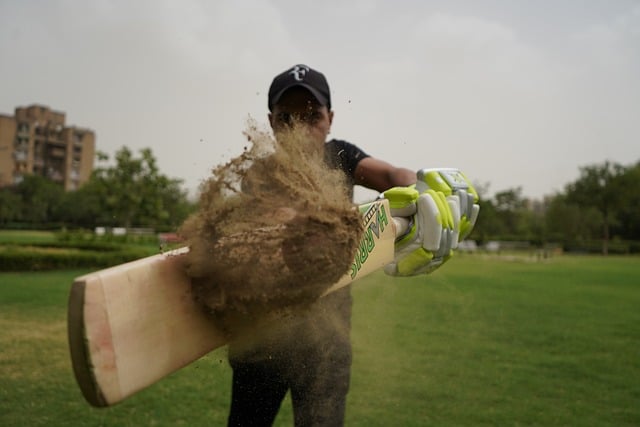The weight of a cricket bat can vary depending on the size, type, and materials used in its construction. Typically, cricket bats come in various weights, ranging from around 2.5 pounds (1.1 kilograms) to 3.5 pounds (1.6 kilograms). The weight of the bat is usually indicated on the sticker or label on the back of the bat, near the handle.
The choice of bat weight depends on the player’s preference, playing style, and physical strength. Some players prefer lighter bats for better maneuverability and quick shots, while others opt for slightly heavier bats for added power and hitting capability. It’s essential for players to try different bat weights and select the one that feels comfortable and allows them to perform optimally on the cricket field.
Cricket Bats Are Limited By Total Dimensions
The International Cricket Council (ICC) has not specified specific weight ranges or limits for cricket bats for men and women but they do have limits for dimensions including length, width, depth and edges. The ICC primarily governs the rules and regulations of the game, but the weight of cricket bats is not a parameter they regulate.
including length, width, depth and edges. The ICC primarily governs the rules and regulations of the game, but the weight of cricket bats is not a parameter they regulate.
Current ICC cricket bat limits are as follows:
- Length of the bat will not exceed 38″ (96.52 cm).
- Width of the bat will not exceed 4.25″ (10.8 cm)
- Depth of the bat will not exceed 2.64″ (6.7 cm)
- Edges of the bat will not exceed 1.56″ (4.0 cm)
The weight of cricket bats is generally left to the discretion of individual players and manufacturers, as long as it falls within reasonable limits for safety and playability. The bat must be able to pass through a bat gauge that the umpire has access to, so in that regard, the lack of weight limit is taken into account by the dimension limits and gauge.
What does this mean for regular cricketers who want to buy a bat?
Weight Limits Of Cricket Bats By Category and Manufacturer
Below is a table with typical weight ranges and examples of major bat manufacturers’ offerings. Keep in mind that these are just general guidelines and may vary based on individual player preferences and bat models.
| Bat Weight Category | Weight Range (in pounds) | Typical Bat Manufacturers |
|---|---|---|
| Light Weight | 2.5 to 2.8 | GM (Gunn & Moore) |
| Kookaburra | ||
| Adidas | ||
| Gray-Nicolls | ||
| Puma | ||
| Medium Weight | 2.9 to 2.11 | SG (Sanspareils Greenlands) |
| Spartan | ||
| New Balance | ||
| Salix | ||
| Heavy Weight | 3.0 to 3.5 | Slazenger |
| BAS (Beat All Sports) | ||
| Sareen Sports (SS) | ||
| Masuri |
Please note that the weight ranges mentioned above are approximate and can vary from bat to bat, even within the same brand or model. The best way to determine the ideal bat weight for you is to visit a sports equipment store, try out different bats, and select one that feels comfortable and suits your playing style and preferences.
Factors That Determine A Cricket Bat’s Weight
- Size and Type of the Bat: Different bat sizes, such as short handle, long handle, and junior sizes, have varying weights. Additionally, the type of bat, whether it’s a traditional wooden bat, a lightweight tennis bat, or a heavier tape ball bat, will impact its overall weight.
- Willow Grade: The quality of the willow wood used in the bat’s construction can influence its weight. Premium English Willow bats tend to have a slightly lighter weight compared to Kashmir Willow bats.
- Blade Shape: Cricket bats come in a variety of shapes and sizes, each with its own strengths and weaknesses. One common shape is the traditional “straight” blade, which has a uniform width and thickness throughout its length. Another popular shape is the “conical” blade, which is wider at the bottom and tapers towards the top. Yet another shape is the “scoop” blade, which has a concave shape on the back of the blade.
- Profile and Thickness: The profile and thickness of the bat impact its weight distribution. Bats with thicker edges and larger sweet spots might be slightly heavier.
- Handle Type: Different handle designs, such as round, oval, or semi-oval, can influence a bat’s weight and feel in the player’s hands.
- Player’s Preference and Style: Each player may have a personal preference for bat weight based on their physical strength, batting style (aggressive, defensive, etc.), and comfort level.
Choosing the Right Cricket Bat Weight
Selecting the appropriate bat weight is essential for a player’s performance and overall comfort. Players should consider the following tips when choosing a bat weight:
- Test multiple bats to find the weight that feels comfortable in your hands and allows you to play your shots effectively.
- Match your bat weight to your physical strength and playing style. Aggressive players may prefer heavier bats, while stroke-makers might opt for lighter ones.
- Consider the pitch conditions and the type of ball you’ll be facing. Lighter bats might be more suitable for bouncy pitches, while heavier bats can be beneficial on slower pitches.
Ultimately, the ideal bat weight varies from player to player. It’s essential to spend time testing different weights, getting a feel for the bat’s balance, and choosing the one that best complements your playing style and skill level.


